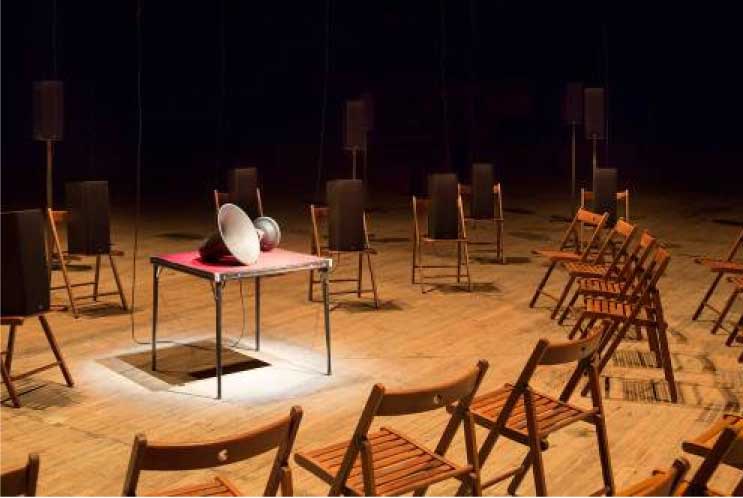
First thoughts after seeing Janet Cardiff and George Bures Miller’s The Murder of Crows: damn, Janet Cardiff has far more narratively satisfying dreams than most.
Second thoughts: as locations for this sound installation, the Park Avenue Armory was a fine choice. “We were in this auditorium but then it turned into a …factory,” Miller says on the recording, and sitting in a dark space in the Armory’s cavernous center, you could be forgiven for finding that image a little too evocative. Most of the Armory’s space was hidden in darkness, and it wasn’t ever clear what lay in that darkness: more speakers, or simply an empty space? Certainly, that space would soon be filled.
Inspired by Francisco Goya’s The Sleep of Reason Produces Monsters, the installation is centered around a table on which an old gramophone speaker sits. Wooden chairs surround it, facing one another in a circle; roughly half, however, are filled with speakers; speakers also dangled from the ceiling, some ominously so. It opened with a recording of Cardiff describing a dream, one full of industrial imagery giving way to multiple evocations of a sinister totalitarian logic and the threat of amputation — a motif that would run throughout the piece.
Much of what makes The Murder of Crows so compelling are the shifts in its narrative: the way that Cardiff’s words vividly summon locations horrific and comforting alike, and the ways in which raw sound can be made to create atmosphere, or imbue the audience with a massive sense of dread. I’d just as soon avoid any more specifics, though I will note that the final minutes of The Murder of Crows offer a dramatic shift from what had come before. What had been a very focused selection of sounds took on a different feeling towards the piece’s conclusion, its channeling of the shifting narrative logic of dreams replaced by a nod towards dreams’ outright surrealism.
And for all that Cardiff and Miller’s narrative slips around, there are clearly themes and images at the edges that slowly make themselves apparent: the horror of amputation; the contrasting of subdued natural spaces with the aftereffects or war or political oppression. The Murder of Crows is a collage full of jarring moments, some of which represent bold intensifications of mood and others which represent leaps that don’t entirely add up. A statement seen as you walk into the Armory raises more questions: Cardiff and Miller’s summoning of the disquiet represented by Goya’s image, and the significance of the “crow funeral” that they also cite as an inspiration. The notion of a tormented sleeper pulled from Goya seems self-evident; the crow funeral seems more mysterious, a channeling of unexplained elements in nature that nonetheless pack a devastating emotional force. Not all of this work’s contortions land with the same impact, but those that do can stay rooted in the subconscious long after the work has been experienced. Maybe they’re returning home.
Photo: James Ewing
Follow Vol. 1 Brooklyn on Twitter, Facebook, Google + and our Tumblr.
